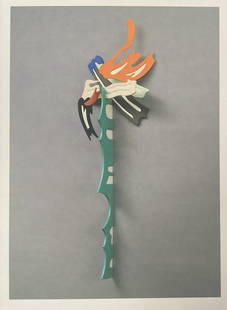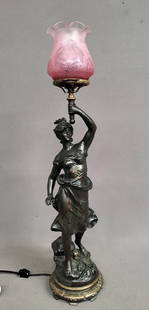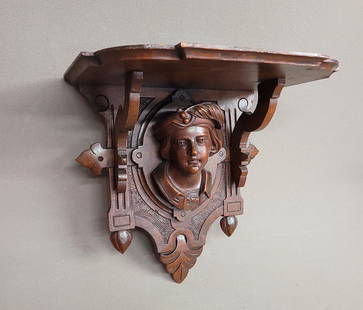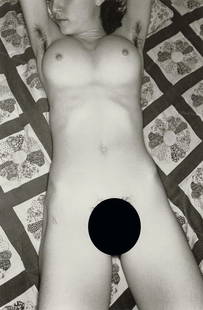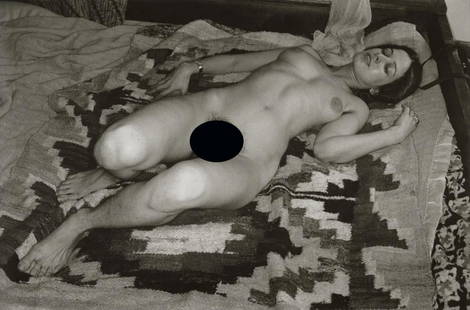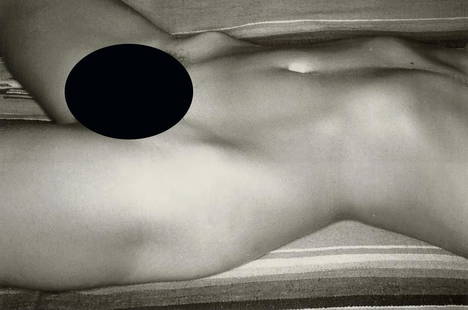
ROY LICHTENSTEIN, Brushstroke Nude, 1993
Similar Sale History
View More Items in Sculptures & CarvingsRelated Sculptures & Carvings
More Items in Sculptures & Carvings
View MoreRecommended Art
View More


Item Details
Description
Brushstroke Nude, 1993. painted cast aluminum 144 1/2 x 42 x 30 in. (367 x 106.7 x 76.2 cm) Signed, inscribed, numbered, and dated “TALLIX, 1/3, rf Lichtenstein ‘93” along the lower edge of the sculpture. This work is number one from an edition of three plus one artist’s proof.Ο
PROVENANCE PaceWildenstein, New York Gagosian Gallery, New York Private collection, New York
EXHIBITED New York, The Solomon R. Guggenheim Museum, Roy Lichtenstein: A Retrospective, New York, October 8, 1993 – January 16, 1994 (another example exhibited) New York, Pace Wildenstein, The Sculpture Garden at 590 Madison Avenue, December 13, 1995 – April 6, 1996 (another example exhibited) Fort Bevedere, Florence, Art/Fashion: Curated by Germano Celant, Ingrid Sichy and Pandora Tabatabai Ashaghi, September 21, 1996 – January 12, 1997 (another example exhibited) Mexico City, Mexico, Museo Del Palacio De Bellas Artes, Salas Nacional Y Diego Rivera, Roy Lichtenstein, Escultura, Pintura Y Grafica, July 9 – October 18, 1998; Monterrey, Museo De Arte Contemporaneo De Monterrey, A. C. November 5, 1998 – January 31 1999; The Corcoran Gallery of Art, Washington, D.C., June 5 – September 30, 1999 as Roy Lichtenstein: Sculpture & Drawings; Valencia, Spain, Instituto Valenciano de Arte Moderno, October 21 – January 9, 2000; La Coruña, Spain, Fundacion Pedro Barrié de la Maza, January 27 – April 30, 2000; Portugal, Lisbon, Centro Cultural de Belem, May 11 – August 15, 2000 (another example exhibited) New York, The Metropolitan Museum of Art, The Iris and B. Gerald Cantor Roof Garden, Roy Lichtenstein: Sculpture on the Roof, May 1 – November 30, 2003 (another example exhibited) London, Gagosian Gallery, Roy Lichtenstein: Sculpture, June 6 – August 6, 2005; New York, Gagosian Gallery, September 16 – October 22, 2005 (another example exhibited) Madrid, Fundacíón Juan March, Roy Lichtenstein: de Principio a Fin, February 3 – May 27, 2007; Paris, France, Pinacothèque de Paris, Roy Lichtenstein: Évolution, June 15 – September 23, 2007. Revised and abridged version Katonah, New York, Katonah Museum of Art, Roy Lichtenstein: In Process, March 29 – June 28, 2009 (another example exhibited) Paris, Tuileries, Las Sculpture Contemporaine au Jardin des Tuileries, October 25, 2007 – April 6, 2010 (another example exhibited) Coral Gables, Florida, Fairchild Tropical Botanic Garden, Roy Lichtenstein at Fairchild: Monumental Sculpture by Roy Lichtenstein, December 8, 2007 – May 31, 2008 (another example exhibited)
LITERATURE Roy Lichtenstein, Monterrey, Instituto Nacional de Bellas Artes, 1998, pp. 194-195 (another example illustrated) C. McGee. “Pop on top this summer at the Met,” Daily News, May 2, 2003, p. 59 (another example illustrated) S. Ratibor and M. Francis, eds., Roy Lichtenstein: Sculpture, New York, Gagosian Gallery, 2005, pp. 94-95 (another example illustrated) J. Cowart, Lichtenstein in Process, New York, Katonah Museum of Art, 2009, p. 69, cat. 40 (another example illustrated)
Having repeatedly visited the forms of the past while demonstrating the maturity of his own painterly hand, Roy Lichtenstein entered the 1990s, his fifth decade of artistic output, as the last living icon of the original Pop movement. But while the final works of Andy Warhol strove for an ever-simplified version of his own style, Lichtenstein’s art grew more wondrously complex with each passing year. Each of his myriad visual tropes became as organic as water, effortlessly decorative yet as resonant as their radical beginnings. Lichtenstein’s artistic fluidity reached its greatest heights in his final years, as he shows us in the present lot, Brushstroke Nude, 1993. The twelve foot tall sculpture stood before The Solomon R. Guggenheim Museum in New York City during Lichtenstein’s 1994 retrospective. Encountering the viewer as he entered the museum, the present lot is a breathtaking testament to the many facets inherent in Roy Lichtenstein’s oeuvre. In Brushstroke Nude, 1993, we witness Lichtenstein’s familiar patterns rich in metaphor, his poignant use of chromatics in three dimensions, and, perhaps most significant, his arthistorical consciousness—the nude, so vital to art forms of the past, asserts her modern form with both astounding sensuality in her grandeur and brilliant freshness in her figure. But the roots of Brushstroke Nude, 1993, stretch back to Lichtenstein’s very beginnings. As a young painter, he shouldered the weight of influence from the Abstract Expressionists. It was a movement that he felt was instrumental in forming his artistic mind, and, in subsequent years, Lichtenstein often revisited Abstract Expressionism with a sense of nostalgic adoration. On occasion, he managed to make seamless pastiche of both the movement’s actions and visual language, as in his telling homage to Willem de Kooning’s Women series, which Lichtenstein painted in 1981 and 1982. The paintings themselves portray a nude figure whose outline is formed by many separate “brushstrokes,” one of Lichtenstein’s many signature visual tropes. The brushstroke itself stems from the most recognizable portion of Lichtenstein’s career, in which he duplicated comic strips on enormous panels. Blowing-up and magnifying the consumer product of the comic, Lichtenstein soon adopted its motifs in his other work. The brushstroke, a graphic representation of a colored smear, arose in 1965, slightly after the Benday-Dot, the magnified circle of print media. These two tropes came to symbolize much of Lichtenstein’s artistic project, namely that of relocating industrial modes of art to the hand of the painter. Critics of both the brushstroke and the Benday-Dot often focused on these motifs and others as insidious attacks on art history, wicked attempts on the conservative means of creating the pictures of the past. Yet as David Hickey points out, the aims of these signs was not artistic fascism or neutrality, but rather to breathe life into a transitioning art form: “Like Andy Warhol’s soup-cans, Lichtenstein’s brushstrokes were, clearly and at first glance, generational icons. They proposed a critique of the immediate past, clearly intending to supercede it without destroying it—to propose something new that would renew the past, as well.”(D. Hickey, “Brushstrokes”, from Brushstrokes: Four Decades, New York, 2002, p. 10). Gliding through the many chapters of his career during the next two decades—from the “mirrors” and “surrealism”, to “futurism” and “Purism”—Lichtenstein benefited from a wealth of artistic pressures. Yet, instead of falling away as he progressed to a new stage of creation, Lichtenstein’s influences became more subtle, and underscored each new piece. His fascination with Leger’s visions of metropolis, embodied in Lichtenstein’s colored vertices of the 1970s, find their surreptitious way into his art of the 1980s. In addition, his thick blocks of color, echoes of Henri Matisse, began to saturate his work in ever more restrained ways as his career wore on. The 1980s in particular bore witness to a revolutionary integration of Lichtenstein’s forms. Reflections on Blonde, 1989, displays Lichtenstein’s conflicting influences in a more obviously warring state, as his Benday-Dots and brushstrokes battle against Leger’s columns and Matisse’s fields of color. One gets the sense that the painting itself is an expression of Lichtenstein’s artistic angst, the shapes and forms wrestling for dominance on the surface of the canvas. From Cubism to Fauvism, from spare to lush, Lichtenstein utilized all of his adopted stylings, occasionally isolating them on a canvas or sculpted figure in order to revisit them more fully. Yet his work in three dimensions was slower to absorb every influence in equality. Lichtenstein’s efforts in sculpture were often more simple and humorous, or sometimes more studious and experimental, than his two dimensional ones. 1982’s Brushstroke gives the viewer a fair representation of Lichtenstein’s early and less than magnificent forays into sculpture. But the sculpted brushstrokes, sitting each on top of one another, demonstrate a frequent theme in Lichtenstein’s three-dimensional work: the concept of playful balance. We find this again in 1987’s Brushstroke Head II, where the figure’s outstretched hair is carefully offset by the weight of the face on the other side. As he was sculpting each piece, usually only utilizing one or two visual tropes at a time, Lichtenstein was preparing for their later collaboration. Visual contests would continue in Lichtenstein’s work, and their diversity of technique and content serve to exposit on his extensive debt to art history. Yet, in the present lot, Brushstroke Nude, 1993, any competition between movements is sidelined, to be replaced by a flawless assimilation of styles. Lichtenstein’s sculpture towers nearly twelve feet, its plane of portraiture twisting 180 degrees at the four-foot mark. The verticality of the structure evokes the groundbreaking sculpture of Constantin Brancusi, most notably his famous Bird in Space, 1923. In terms of its visual dynamics, the subject of the present lot is at once three-pronged and singular. On one hand the lone nude figure of a woman stretches vertically, contrary to her more prone historical incarnations. While her lower half is more abstract, standing upon the support of three liquid feet, she gains definition as the viewer shifts his eyes skyward. Baring a more restrained voluptuousness than, say, Titian’s Venus of Urbino, 1538, her bare breasts evolve from the sculpted pattern upon the flat metal that forms her torso, two colorless recesses that signify her boundless femininity. One slender arm falls to her side, holding steady with the curve of her hip. The other, diminutive, perhaps in an attempt to suggst its positioning behind her back, thrusts its shoulder upward and back, confident in its own sexuality. Finally, her head, sitting atop her rounded neck in perfect balance, glares sideways, lips gently parted. If the viewer were to assume a position to the front of the enormous sculpture, gazing at the narrow contour of her face, he would observe a face staring into the brightness of pure expression, her windswept hair trailing behind her. On the other hand, the alternative, three-pronged subject of Brushstroke Nude, 1993, is Lichtenstein’s revival of his past visual tropes. From head to foot, the topography of his nude is clearly defined by three forms: the Benday-Dot, Lichtenstein’s binary mode of coloring, and, of course, the Brushstroke that composes her. Filling the brightly painted aluminum in only selected areas, Lichtenstein’s Benday-Dots each measure about two inches in diameter, some of their largest expressions in his oeuvre. These enormous replicas of industrial print methods now give our nude figure a dimension of reflectivity, much as they did in Lichtenstein’s “mirror” phase. Yet it would be wrong to say that the dots give exact suggestions of shape or contour on the flat surface of the twisting sculpture, or that their presence in one area has some sort of definitive meaning. Rather, as they adorn the front leaning portion of the torso along with the very crown of our nude’s body, they lend a sensual texture to her. Alternatively, Lichtenstein’s choice of chromatic duality forces us to critically investigate the piece. Shining a brilliant blue on one side and a rich red on the other, the nude figure seems to have two personalities within her: one a relaxed and attractive confidence and the other an all-encompassing passion. We also see, in tiny bits here and there, small marks of opposite coloring, as in blue’s presence at the breast of the red side or red’s semi-circle under the shoulder on blue’s, Yet Lichtenstein’s most brilliant move in his coloring is the vexation he has imposed upon the viewer; one can never view only one coloration of the nude, as both the cool and hot are visible at all times as she twists. Her movement seems to imply that she is suffering from a battle of mind and heart, each vulnerable to the whims of the other. Finally, there is the brushstroke itself. Rendering her both abstract and quite defined. Lichtenstein’s enormous stroke of paint is whimsical in its choice of physical accoutrement. For example, while the figure lacks the presence of any real feet, instead allowing three hoof-like pillars to be her support, her arms boast anatomical exactness; they have both elbows and visible muscle tone. Yet the hair whisking behind the head is surely Lichtenstein’s most poetically rendered stroke. Doubling as both her feminine locks and as the last vestiges of a spent paintbrush’s efforts, the nude’s hair attains as a gorgeous unity of form and subject. Rendering the present lot in a collaboration of Benday-Dots and one long, simulated brushstroke, Lichtenstein enjoins two of the greatest visual tropes of his career, and, in doing so, transforms the eternal nude into a modern marvel of Pop Art iconography. Along with his spectacular consolidation of his own personal forms, we must also observe Lichtenstein’s advancement of the nude in history. Spending centuries lounging among tapestries and embellished with aristocratic jewelry, the female nude has always seemed to represent the unbridled expression of the subject. No figure more provokes the viewing public into a state of wonder or titillation; while, in the comments and documents of art history, the subject of the nude is often hotly debated and even divisive. But while Titian, Matisse, and even de Kooning gave us frontal views of their nude women, complete with facial expression, Lichtenstein gives us so much more. His choice of a 360 degree vantage point conjures most convincingly the mid-career work of Picasso, in particular Femme couchée (Reclining woman), 1932, as we see in the similar facial profiles and windows into multiple visual perspectives. As one revolves around Brushstroke Nude, first noting her size, then her duality, then finally her multitude of twisting ornamentation, he cannot help but see many sides to her, both literal and metaphorical. In addition, Lichtenstein’s rendering passes the historical nude through the filter of Pop Art, and, in doing so, we behold a wealth of implications. Firstly, torn away from her bed sheets and thrown onto her feet, we witness a renewed strength in the female nude, adamant in her metal casting. In addition, her permanent profile is emblematic of a rebellion, as if she has more important things to do than be motionless as an object of the masculine gaze. Finally, as she is adorned with the many forms of industrial art that define Lichtenstein’s career, the nude is a comment on the post-modern consciousness: as we bear both the pleasant imprints and painful scars of commercialism on our souls, we witness art’s fundamental change expressed through an eternal figure. But beyond all of the radical Pop Art critiques of modern culture, Lichtenstein has discovered the same truth of the female nude as his many historical counterparts. As the nude herself is composed of Lichtenstein’s Benday-Dots and simulated brushstroke, the subject is almost a side product of Lichtenstein’s characteristic forms. It is as if the female nude, that staple of art history, is as much an inevitable conclusion of technique as she is its inspiration. And, perhaps most poignantly, Lichtenstein’s seamless fusion of figuratism and abstraction is breathtaking to behold—the collapse of each technique begets a form that Lichtenstein alone has perfected.
PROVENANCE PaceWildenstein, New York Gagosian Gallery, New York Private collection, New York
EXHIBITED New York, The Solomon R. Guggenheim Museum, Roy Lichtenstein: A Retrospective, New York, October 8, 1993 – January 16, 1994 (another example exhibited) New York, Pace Wildenstein, The Sculpture Garden at 590 Madison Avenue, December 13, 1995 – April 6, 1996 (another example exhibited) Fort Bevedere, Florence, Art/Fashion: Curated by Germano Celant, Ingrid Sichy and Pandora Tabatabai Ashaghi, September 21, 1996 – January 12, 1997 (another example exhibited) Mexico City, Mexico, Museo Del Palacio De Bellas Artes, Salas Nacional Y Diego Rivera, Roy Lichtenstein, Escultura, Pintura Y Grafica, July 9 – October 18, 1998; Monterrey, Museo De Arte Contemporaneo De Monterrey, A. C. November 5, 1998 – January 31 1999; The Corcoran Gallery of Art, Washington, D.C., June 5 – September 30, 1999 as Roy Lichtenstein: Sculpture & Drawings; Valencia, Spain, Instituto Valenciano de Arte Moderno, October 21 – January 9, 2000; La Coruña, Spain, Fundacion Pedro Barrié de la Maza, January 27 – April 30, 2000; Portugal, Lisbon, Centro Cultural de Belem, May 11 – August 15, 2000 (another example exhibited) New York, The Metropolitan Museum of Art, The Iris and B. Gerald Cantor Roof Garden, Roy Lichtenstein: Sculpture on the Roof, May 1 – November 30, 2003 (another example exhibited) London, Gagosian Gallery, Roy Lichtenstein: Sculpture, June 6 – August 6, 2005; New York, Gagosian Gallery, September 16 – October 22, 2005 (another example exhibited) Madrid, Fundacíón Juan March, Roy Lichtenstein: de Principio a Fin, February 3 – May 27, 2007; Paris, France, Pinacothèque de Paris, Roy Lichtenstein: Évolution, June 15 – September 23, 2007. Revised and abridged version Katonah, New York, Katonah Museum of Art, Roy Lichtenstein: In Process, March 29 – June 28, 2009 (another example exhibited) Paris, Tuileries, Las Sculpture Contemporaine au Jardin des Tuileries, October 25, 2007 – April 6, 2010 (another example exhibited) Coral Gables, Florida, Fairchild Tropical Botanic Garden, Roy Lichtenstein at Fairchild: Monumental Sculpture by Roy Lichtenstein, December 8, 2007 – May 31, 2008 (another example exhibited)
LITERATURE Roy Lichtenstein, Monterrey, Instituto Nacional de Bellas Artes, 1998, pp. 194-195 (another example illustrated) C. McGee. “Pop on top this summer at the Met,” Daily News, May 2, 2003, p. 59 (another example illustrated) S. Ratibor and M. Francis, eds., Roy Lichtenstein: Sculpture, New York, Gagosian Gallery, 2005, pp. 94-95 (another example illustrated) J. Cowart, Lichtenstein in Process, New York, Katonah Museum of Art, 2009, p. 69, cat. 40 (another example illustrated)
Having repeatedly visited the forms of the past while demonstrating the maturity of his own painterly hand, Roy Lichtenstein entered the 1990s, his fifth decade of artistic output, as the last living icon of the original Pop movement. But while the final works of Andy Warhol strove for an ever-simplified version of his own style, Lichtenstein’s art grew more wondrously complex with each passing year. Each of his myriad visual tropes became as organic as water, effortlessly decorative yet as resonant as their radical beginnings. Lichtenstein’s artistic fluidity reached its greatest heights in his final years, as he shows us in the present lot, Brushstroke Nude, 1993. The twelve foot tall sculpture stood before The Solomon R. Guggenheim Museum in New York City during Lichtenstein’s 1994 retrospective. Encountering the viewer as he entered the museum, the present lot is a breathtaking testament to the many facets inherent in Roy Lichtenstein’s oeuvre. In Brushstroke Nude, 1993, we witness Lichtenstein’s familiar patterns rich in metaphor, his poignant use of chromatics in three dimensions, and, perhaps most significant, his arthistorical consciousness—the nude, so vital to art forms of the past, asserts her modern form with both astounding sensuality in her grandeur and brilliant freshness in her figure. But the roots of Brushstroke Nude, 1993, stretch back to Lichtenstein’s very beginnings. As a young painter, he shouldered the weight of influence from the Abstract Expressionists. It was a movement that he felt was instrumental in forming his artistic mind, and, in subsequent years, Lichtenstein often revisited Abstract Expressionism with a sense of nostalgic adoration. On occasion, he managed to make seamless pastiche of both the movement’s actions and visual language, as in his telling homage to Willem de Kooning’s Women series, which Lichtenstein painted in 1981 and 1982. The paintings themselves portray a nude figure whose outline is formed by many separate “brushstrokes,” one of Lichtenstein’s many signature visual tropes. The brushstroke itself stems from the most recognizable portion of Lichtenstein’s career, in which he duplicated comic strips on enormous panels. Blowing-up and magnifying the consumer product of the comic, Lichtenstein soon adopted its motifs in his other work. The brushstroke, a graphic representation of a colored smear, arose in 1965, slightly after the Benday-Dot, the magnified circle of print media. These two tropes came to symbolize much of Lichtenstein’s artistic project, namely that of relocating industrial modes of art to the hand of the painter. Critics of both the brushstroke and the Benday-Dot often focused on these motifs and others as insidious attacks on art history, wicked attempts on the conservative means of creating the pictures of the past. Yet as David Hickey points out, the aims of these signs was not artistic fascism or neutrality, but rather to breathe life into a transitioning art form: “Like Andy Warhol’s soup-cans, Lichtenstein’s brushstrokes were, clearly and at first glance, generational icons. They proposed a critique of the immediate past, clearly intending to supercede it without destroying it—to propose something new that would renew the past, as well.”(D. Hickey, “Brushstrokes”, from Brushstrokes: Four Decades, New York, 2002, p. 10). Gliding through the many chapters of his career during the next two decades—from the “mirrors” and “surrealism”, to “futurism” and “Purism”—Lichtenstein benefited from a wealth of artistic pressures. Yet, instead of falling away as he progressed to a new stage of creation, Lichtenstein’s influences became more subtle, and underscored each new piece. His fascination with Leger’s visions of metropolis, embodied in Lichtenstein’s colored vertices of the 1970s, find their surreptitious way into his art of the 1980s. In addition, his thick blocks of color, echoes of Henri Matisse, began to saturate his work in ever more restrained ways as his career wore on. The 1980s in particular bore witness to a revolutionary integration of Lichtenstein’s forms. Reflections on Blonde, 1989, displays Lichtenstein’s conflicting influences in a more obviously warring state, as his Benday-Dots and brushstrokes battle against Leger’s columns and Matisse’s fields of color. One gets the sense that the painting itself is an expression of Lichtenstein’s artistic angst, the shapes and forms wrestling for dominance on the surface of the canvas. From Cubism to Fauvism, from spare to lush, Lichtenstein utilized all of his adopted stylings, occasionally isolating them on a canvas or sculpted figure in order to revisit them more fully. Yet his work in three dimensions was slower to absorb every influence in equality. Lichtenstein’s efforts in sculpture were often more simple and humorous, or sometimes more studious and experimental, than his two dimensional ones. 1982’s Brushstroke gives the viewer a fair representation of Lichtenstein’s early and less than magnificent forays into sculpture. But the sculpted brushstrokes, sitting each on top of one another, demonstrate a frequent theme in Lichtenstein’s three-dimensional work: the concept of playful balance. We find this again in 1987’s Brushstroke Head II, where the figure’s outstretched hair is carefully offset by the weight of the face on the other side. As he was sculpting each piece, usually only utilizing one or two visual tropes at a time, Lichtenstein was preparing for their later collaboration. Visual contests would continue in Lichtenstein’s work, and their diversity of technique and content serve to exposit on his extensive debt to art history. Yet, in the present lot, Brushstroke Nude, 1993, any competition between movements is sidelined, to be replaced by a flawless assimilation of styles. Lichtenstein’s sculpture towers nearly twelve feet, its plane of portraiture twisting 180 degrees at the four-foot mark. The verticality of the structure evokes the groundbreaking sculpture of Constantin Brancusi, most notably his famous Bird in Space, 1923. In terms of its visual dynamics, the subject of the present lot is at once three-pronged and singular. On one hand the lone nude figure of a woman stretches vertically, contrary to her more prone historical incarnations. While her lower half is more abstract, standing upon the support of three liquid feet, she gains definition as the viewer shifts his eyes skyward. Baring a more restrained voluptuousness than, say, Titian’s Venus of Urbino, 1538, her bare breasts evolve from the sculpted pattern upon the flat metal that forms her torso, two colorless recesses that signify her boundless femininity. One slender arm falls to her side, holding steady with the curve of her hip. The other, diminutive, perhaps in an attempt to suggst its positioning behind her back, thrusts its shoulder upward and back, confident in its own sexuality. Finally, her head, sitting atop her rounded neck in perfect balance, glares sideways, lips gently parted. If the viewer were to assume a position to the front of the enormous sculpture, gazing at the narrow contour of her face, he would observe a face staring into the brightness of pure expression, her windswept hair trailing behind her. On the other hand, the alternative, three-pronged subject of Brushstroke Nude, 1993, is Lichtenstein’s revival of his past visual tropes. From head to foot, the topography of his nude is clearly defined by three forms: the Benday-Dot, Lichtenstein’s binary mode of coloring, and, of course, the Brushstroke that composes her. Filling the brightly painted aluminum in only selected areas, Lichtenstein’s Benday-Dots each measure about two inches in diameter, some of their largest expressions in his oeuvre. These enormous replicas of industrial print methods now give our nude figure a dimension of reflectivity, much as they did in Lichtenstein’s “mirror” phase. Yet it would be wrong to say that the dots give exact suggestions of shape or contour on the flat surface of the twisting sculpture, or that their presence in one area has some sort of definitive meaning. Rather, as they adorn the front leaning portion of the torso along with the very crown of our nude’s body, they lend a sensual texture to her. Alternatively, Lichtenstein’s choice of chromatic duality forces us to critically investigate the piece. Shining a brilliant blue on one side and a rich red on the other, the nude figure seems to have two personalities within her: one a relaxed and attractive confidence and the other an all-encompassing passion. We also see, in tiny bits here and there, small marks of opposite coloring, as in blue’s presence at the breast of the red side or red’s semi-circle under the shoulder on blue’s, Yet Lichtenstein’s most brilliant move in his coloring is the vexation he has imposed upon the viewer; one can never view only one coloration of the nude, as both the cool and hot are visible at all times as she twists. Her movement seems to imply that she is suffering from a battle of mind and heart, each vulnerable to the whims of the other. Finally, there is the brushstroke itself. Rendering her both abstract and quite defined. Lichtenstein’s enormous stroke of paint is whimsical in its choice of physical accoutrement. For example, while the figure lacks the presence of any real feet, instead allowing three hoof-like pillars to be her support, her arms boast anatomical exactness; they have both elbows and visible muscle tone. Yet the hair whisking behind the head is surely Lichtenstein’s most poetically rendered stroke. Doubling as both her feminine locks and as the last vestiges of a spent paintbrush’s efforts, the nude’s hair attains as a gorgeous unity of form and subject. Rendering the present lot in a collaboration of Benday-Dots and one long, simulated brushstroke, Lichtenstein enjoins two of the greatest visual tropes of his career, and, in doing so, transforms the eternal nude into a modern marvel of Pop Art iconography. Along with his spectacular consolidation of his own personal forms, we must also observe Lichtenstein’s advancement of the nude in history. Spending centuries lounging among tapestries and embellished with aristocratic jewelry, the female nude has always seemed to represent the unbridled expression of the subject. No figure more provokes the viewing public into a state of wonder or titillation; while, in the comments and documents of art history, the subject of the nude is often hotly debated and even divisive. But while Titian, Matisse, and even de Kooning gave us frontal views of their nude women, complete with facial expression, Lichtenstein gives us so much more. His choice of a 360 degree vantage point conjures most convincingly the mid-career work of Picasso, in particular Femme couchée (Reclining woman), 1932, as we see in the similar facial profiles and windows into multiple visual perspectives. As one revolves around Brushstroke Nude, first noting her size, then her duality, then finally her multitude of twisting ornamentation, he cannot help but see many sides to her, both literal and metaphorical. In addition, Lichtenstein’s rendering passes the historical nude through the filter of Pop Art, and, in doing so, we behold a wealth of implications. Firstly, torn away from her bed sheets and thrown onto her feet, we witness a renewed strength in the female nude, adamant in her metal casting. In addition, her permanent profile is emblematic of a rebellion, as if she has more important things to do than be motionless as an object of the masculine gaze. Finally, as she is adorned with the many forms of industrial art that define Lichtenstein’s career, the nude is a comment on the post-modern consciousness: as we bear both the pleasant imprints and painful scars of commercialism on our souls, we witness art’s fundamental change expressed through an eternal figure. But beyond all of the radical Pop Art critiques of modern culture, Lichtenstein has discovered the same truth of the female nude as his many historical counterparts. As the nude herself is composed of Lichtenstein’s Benday-Dots and simulated brushstroke, the subject is almost a side product of Lichtenstein’s characteristic forms. It is as if the female nude, that staple of art history, is as much an inevitable conclusion of technique as she is its inspiration. And, perhaps most poignantly, Lichtenstein’s seamless fusion of figuratism and abstraction is breathtaking to behold—the collapse of each technique begets a form that Lichtenstein alone has perfected.
Buyer's Premium
- 25% up to $50,000.00
- 20% up to $1,000,000.00
- 12% above $1,000,000.00
ROY LICHTENSTEIN, Brushstroke Nude, 1993
Estimate $5,000,000 - $7,000,000
7 bidders are watching this item.
Shipping & Pickup Options
Item located in New York, NY, usSee Policy for Shipping
Payment
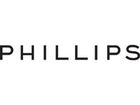
Related Searches
TOP
























